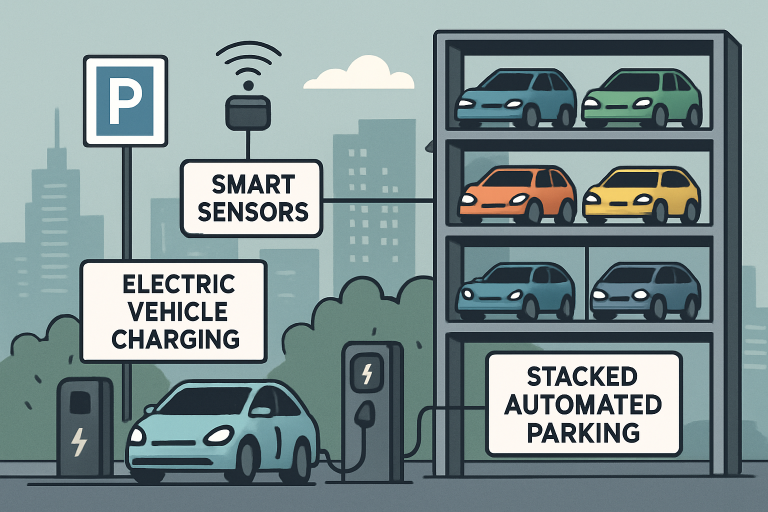Key Takeaways
- Automated Parking Systems (APS) maximize space efficiency and enhance security.
- Smart parking technologies provide real-time updates on availability, reducing search times.
- Dynamic pricing models promote optimal utilization of parking spaces.
- Integration of Electric Vehicle (EV) charging stations supports sustainable transportation.
- Shared parking models and repurposing underutilized spaces alleviate parking shortages.
As urban centers swell with growing populations and vehicle ownership rates, city planners and drivers alike face intensifying parking challenges. Traditional lot-based and street parking systems struggle against space constraints and rising congestion, leading to increased emissions and frustrated commuters. Amid these pressures, new approaches—such as integrated license plate recognition systems—are redefining how cities manage parking, enhancing efficiency and security.
Many cities are using technology like automated parking and smart guidance to reduce demand and enhance user experience while promoting sustainability. These solutions focus on connectivity, automation, and real-time data as models for urban mobility. Addressing parking issues involves valuing land better, repurposing idle areas, and adopting shared-use models to cut traffic and pollution. Adding EV charging infrastructure supports greener cities, making parking systems key to environmental goals. This guide highlights how cities worldwide use innovation and technology—such as dynamic pricing and multifunctional platforms—to address mobility challenges and improve urban living.
Automated Parking Systems
Automated Parking Systems (APS) are reshaping urban landscapes by stacking and lifting vehicles using robotic technology, thereby maximizing the usage of vertical space and reducing the land footprint required for parking. These smart storage solutions can nearly double parking capacity compared to conventional lots, eliminating the need for drive aisles and reducing opportunities for theft by limiting unauthorized access. In cities such as Chicago, APS has helped to optimize high-demand parking areas, providing both convenience and peace of mind for car owners.
Besides boosting capacity, APS also lowers operational costs for parking operators as systems are less labor-intensive and vehicles are less prone to accidental damage. Modern designs prioritize ease of use, featuring intuitive interfaces that guide drivers and streamline entry and retrieval processes.
Smart Parking Technologies
The rise of smart parking tech helps drivers find spaces easily by using IoT sensors and real-time data, shown on apps and signs. Barcelona’s Smart Parking Program uses sensors and apps to guide drivers to open spots, reducing congestion and search time. These systems let officials gather detailed data for planning and help cut city emissions by decreasing the time drivers spend searching for parking.
Dynamic Pricing Models
Cities use dynamic pricing to ease peak congestion and optimize parking. By adjusting rates based on demand, these systems promote quicker turnover and more efficient space utilization. San Francisco’s SFpark uses live data to manage prices, reducing traffic and search times. It also generates revenue to invest in infrastructure or transit. This approach enables cities to manage congestion while striking a balance between public needs and financial health.
EV Charging Integration
As electric vehicle adoption accelerates, convenient charging has become essential in modern parking facilities. Developers partner with companies like BP Pulse to install high-speed chargers in city garages, enabling EV owners to top up their vehicles during errands or at work. Seamless access to charging infrastructure supports drivers and promotes municipal sustainability by encouraging the use of cleaner energy. Integrated “park and charge’ solutions are increasingly popular, encouraging EV adoption and addressing limited charging in dense areas.
Shared Parking Models
Shared parking transforms idle private spaces, such as offices, residential areas, and schools, into community assets through digital booking systems. This improves space use, cuts surface lot needs, and promotes multi-use developments. Owners earn passive income, and users benefit from reliable parking, which reduces traffic, pollution, and accidents.
Repurposing Underutilized Spaces
Temporary transformation of vacant lots, plazas, and underused sites offers flexible parking during festivals, shopping peaks, or city events. Cities like Seattle and Chicago have implemented successful pop-up parking initiatives using modular materials and barriers to add capacity, resulting in a reduction of congestion by up to 30%. Repurposing also involves integrating sustainable features, such as solar canopies or stormwater systems, to address parking shortages and support greener city goals, land stewardship, and environmental resilience.
Conclusion
Innovative parking solutions are essential to the evolving needs of busy urban areas. By integrating automation, real-time technology, dynamic pricing, EV charging, and creative uses of underutilized space, cities can reduce bottlenecks, enhance mobility, and promote long-term sustainability. Collaboration among public agencies, private sector partners, and local communities will be crucial in unlocking the full potential of these strategies.






